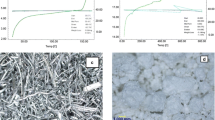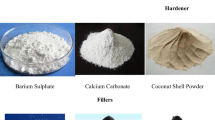Abstract
This paper presents the development and characterization of new natural fibre reinforced composite brake friction materials with a view to replace the asbestos fibre material whose dust is carcinogenic and has harmful effect on human beings. Five different laboratory formulations were prepared with varying coir fibre contents such as, 0, 5, 10, 15 and 20 % volume fraction along with binder, friction modifiers, abrasive material and solid lubricant using powder metallurgy technique. The properties examined are porosity, microstructural morphology, hardness, compressive strength and wear using tensiometer, scanning electron microscopy, hardness tester, universal testing machine and CHASE dynamometer wear machine, respectively. Experimental results showed that higher density, lower porosity, higher compressive strength and lower wear weight loss were obtained from 5 % volume fraction of coir fibre reinforced composite. The microstructure reveals uniform distribution of coir fibre in the matrix as well. It can be concluded that 5 % volume fraction of coir fibre showed better physio-mechanical and wear properties compared to other formulations. Hence, natural coir fibre can be a potential candidate filler material for the mass-scale fabrication of asbestos-free new brake pad without any harmful effect.

Similar content being viewed by others
References
Solomon, D.G.; Berhan, M.N.: Characterization of friction material formulations for brake pads. In: Proceedings of the World Congress on Engineering 2007, vol. II, pp. 1–5 (2007)
Aigbodion V.S., Akaide U., Hassan S.B., Asuke F., Agunsoye J.O: Development of asbestos—Free Brake Pad Using Bagasse. Tribol. Ind. 32(1), 12–18 (2010)
Dagwa I.M., Ibhadode A.O.A: Determination of optimum manufacturing conditions for asbestos-free brake pad using Taguchi method. Niger. J. Eng. Res. Dev. 5(4), 1–8 (2006)
Savage, L.: Eco-friendly brake pads promise greener transport (2007), pp. 1–2. http://www.ohlsti.co.uk/ohl/stipdfs/ohl_sti74.pdf
Sapuan, S.M.; Harimi, M.; Maleque, M. A.: Mechanical properties of epoxy/coconut shell filler particle composites. Arab. J. Sci. Eng. 28(2B), 173 (2003)
Maleque, M.A.; Belal, F.Y.; Sapuan, S.M.: Mechanical properties of pseudo-stem banana fiber reinforced epoxy composite. Arab. J. Sci. Eng. 32(2B), 359 (2007)
Xin X., Xu C.G., Qing L.F: Friction properties of sisal fibre reinforced resin brake composites. Wear 262, 736–741 (2007)
Fushan H., Chenghui G., Shaoyan Y: Effect of bamboo fiber modification on tribological performance of brake composites. Adv. Mater. Res. 150(−151), 1801–1805 (2011)
Hee K.W., Filp P: Performance of ceramic enhanced phenolic matrix brake lining materials for automotive brake lining. Wear 259, 1088–1096 (2005)
Angelo, P.C.; Subramanian, R.: Powder Metallurgy: Science, Technology and Applications, 2nd edn, pp. 6–7. PHI Learning Pvt. Ltd., New Delhi (2009)
Asif, M.; Chandra, K.; Misra, P.S.: Development of iron based brake friction material by hot powder preform forging technique used for medium to heavy duty applications. J. Miner. Mater. Charact. Eng. 10(3), 231–244 (2011)
Langer A.M: Reduction of the biological potential of chrysotile asbestos arising from condition of service on brake pads. Regul. Toxicol. Pharmacol. USA 38(1), 71–77 (2002)
Japan Industrial Standard, Test Procedure of Porosity for Brake Linings and Pad Formulation, JIS D 4418 (1996)
Malaysian Standard Method of Test for Automotive Friction Materials (Brake Linings, Disc Pads and Bonded Shoe): Rockwell Hardness Test (First Revision), MS 474, Part 2, (2003)
Sasaki, Y.: Development philosophy of friction materials for automobile disc brakes. In: The Eight International Pacific Conference on Automobile Engineering. Society of Automobile Engineers of Japan, Society of Automobile Engineer of Japan, pp. 407–412 (1995)
German, R.M.: Powder Metallurgy Science, 2nd edn, pp. 191–195. Metal Powder Industries Federation, Princeton, NJ (1997)
Eriksson M., Bergman F., Jacobson S: Surface characterization of brake pads after running under silent and squealing conditions. Wear 232, 163–167 (1999)
Malaysian Standard, Method of Test for Automotive Friction Materials (Brake Linings, Disc Pads and Bonded Shoe): Specific Gravity (First Revision), MS 474, Part 1, (2003)
Author information
Authors and Affiliations
Corresponding author
Rights and permissions
About this article
Cite this article
Maleque, M.A., Atiqah, A. Development and Characterization of Coir Fibre Reinforced Composite Brake Friction Materials. Arab J Sci Eng 38, 3191–3199 (2013). https://doi.org/10.1007/s13369-012-0454-4
Received:
Accepted:
Published:
Issue Date:
DOI: https://doi.org/10.1007/s13369-012-0454-4




